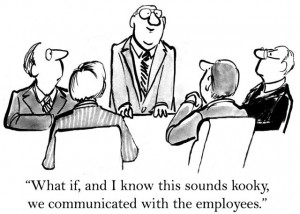 Communication problems in the workplace are inevitable. As organizations grow, communication becomes harder. When there were only a handful of employees, staff meetings were done spontaneously by simply rolling your chairs around the boss’ table. However, with so many employees occupying different departments and areas, this simple campfire style meeting can no longer be done.
Communication problems in the workplace are inevitable. As organizations grow, communication becomes harder. When there were only a handful of employees, staff meetings were done spontaneously by simply rolling your chairs around the boss’ table. However, with so many employees occupying different departments and areas, this simple campfire style meeting can no longer be done.
A strategic information dissemination plan is necessary to ensure that there are no communication gaps across the organization. Remember, the longer information doesn’t go from top-down– from CEO to employees and vice versa, the more the organization will suffer. Organizational growth and efficiency will be hampered, and communication problems in the workplace will take place.
Experts classified good organizational communication to include the following:
Intimacy (Yes, intimacy!)
Multinational companies have offices and people working in vast distances. While physical proximity may not always be possible, there should always be a culture of trust among each other. It doesn’t matter if meetings need to be done virtually, as long as the mission, vision, and goals are communicated effectively. To build a good level of intimacy, leadership people must listen genuinely to what their employees have to say. Sharing of information must be from the top up to the most bottom people in the chain to avoid communication problems in the workplace.
Interactivity
Communication is a two-way street. If it was just you talking, then it’s just a monologue, not communication. The act of talking and the value of listening must be practiced in such a way that the other person’s response will be heard, understood and responded to. In essence, if your talk won’t be affected by what the other person says, then you’re not communicating at all.
Bigger organizations may have a much harder time practicing interactivity, but with the help of technology, even multinational companies with offices in different continents can interact. With the rise of social media tools, personal, face-to-face communication can be mimicked through online communication threads, video messaging/ chat blogs, and social sites like Twitter and Facebook. It’s amazing how high tech tools can eliminate communication problems in the workplace.
Inclusion
Effective communication is allowing every member of the organization to have a voice and to be heard. Allow people to speak about the company and the business in an authentic way. Don’t hamper what they have to say with corporate jargon and complex marketing materials—people want genuine conversations. Don’t filter out information; let it reach its listeners in the most organic way possible, just like a sincere conversation with a friend.
Intentionality
This is a major component of effective communication. Leadership people must always make sure that their agenda and purpose is conveyed well to their listeners. Don’t just blabber about- talk with a purpose in mind to achieve a desired result.
Talk to your employees with compassion, inclusion, intentionality, and interactivity; in this way, you will be able to avoid communication problems in the workplace.
® 2013 Incedo Group, LLC





